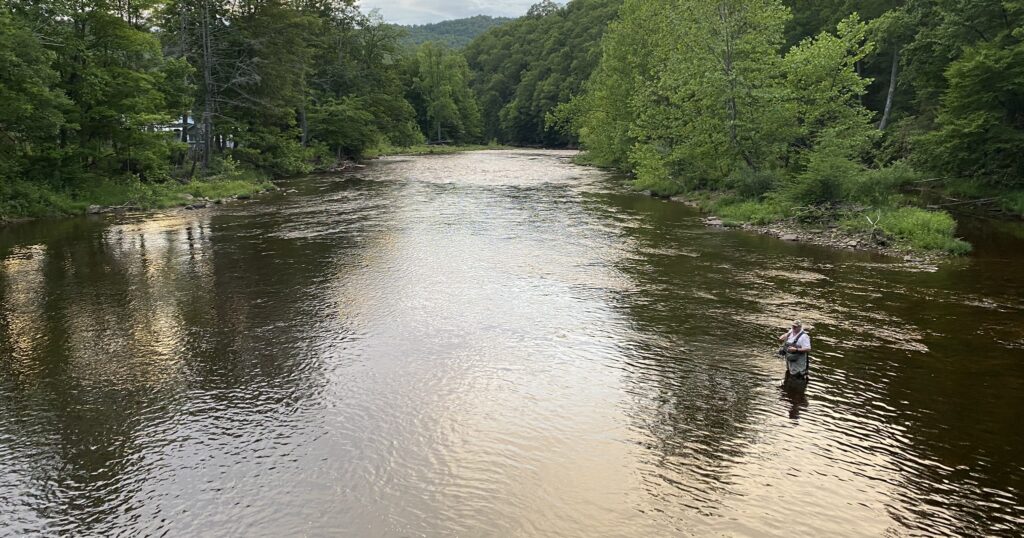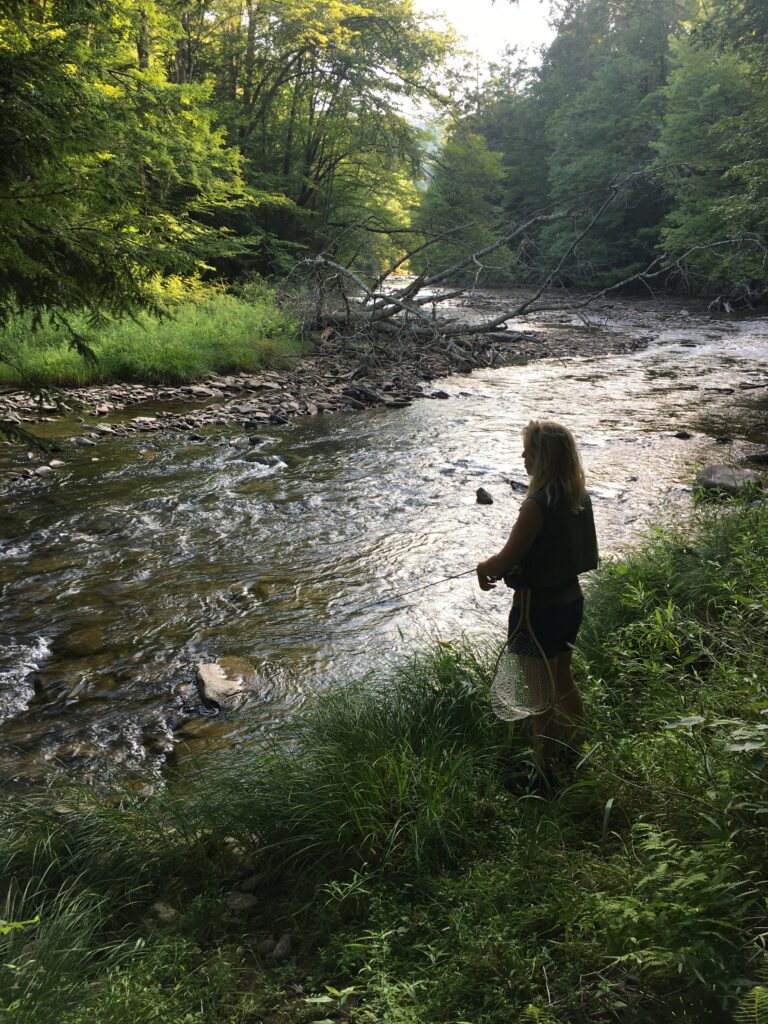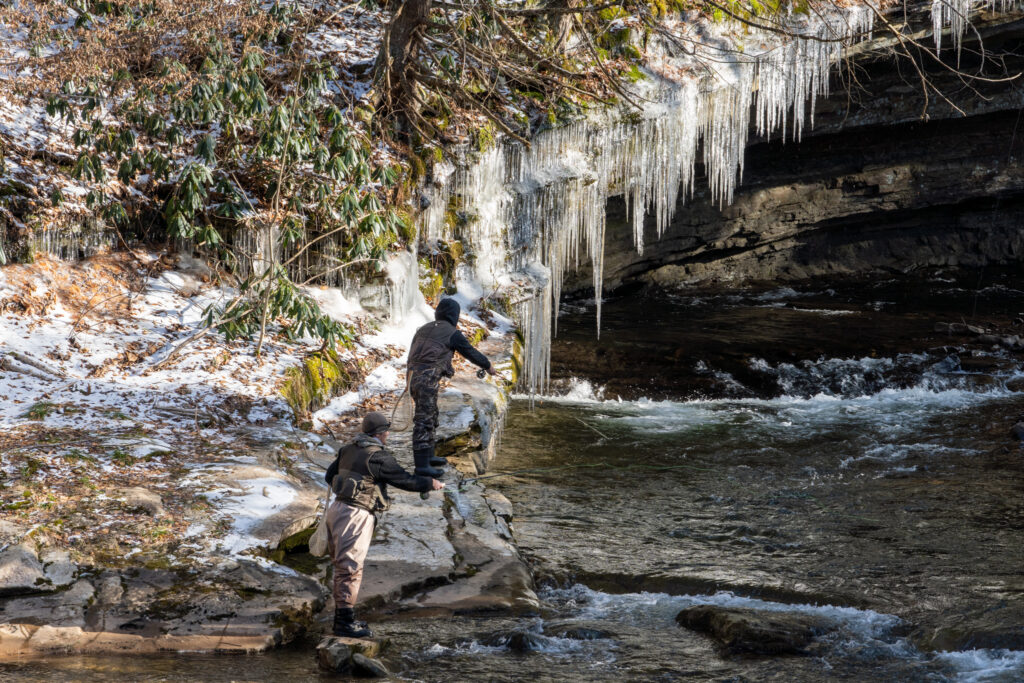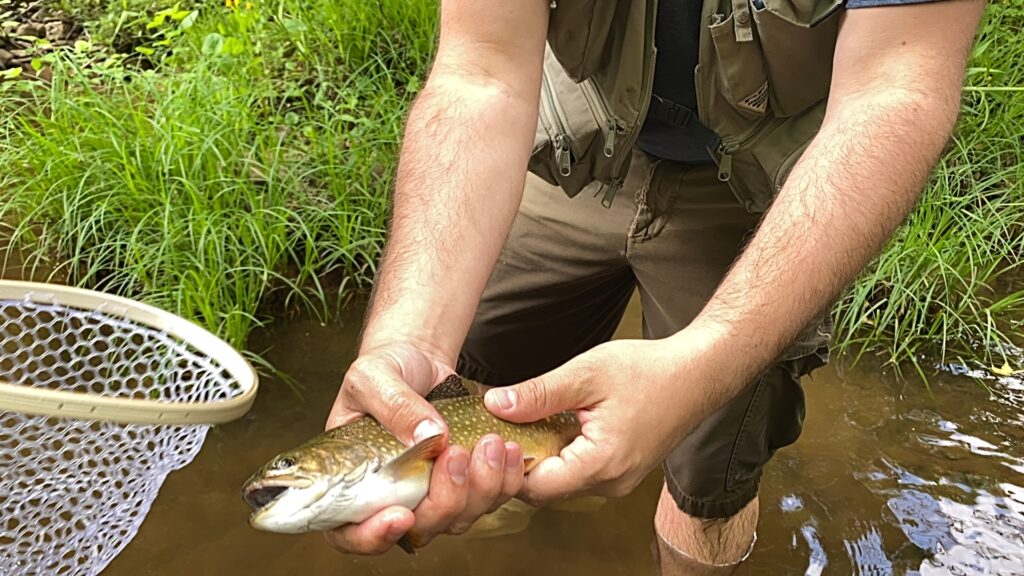 Few things give more satisfaction than a line quietly whipping through the air and the babble of the river as you try to lure in the “big one” with your fly resting on the surface of the water before methodically repeating the process. Fishing is not an easy sport, but it will truly get you hooked on the outdoors. Whether you catch a mess of fish or none at all (it is called fishing, not catching for a reason), being on the river and enjoying the wild scenery and solitude is what it is all about. West Virginia is filled with a variety of lakes, streams, and rivers, making the state an angler’s paradise.
Few things give more satisfaction than a line quietly whipping through the air and the babble of the river as you try to lure in the “big one” with your fly resting on the surface of the water before methodically repeating the process. Fishing is not an easy sport, but it will truly get you hooked on the outdoors. Whether you catch a mess of fish or none at all (it is called fishing, not catching for a reason), being on the river and enjoying the wild scenery and solitude is what it is all about. West Virginia is filled with a variety of lakes, streams, and rivers, making the state an angler’s paradise.
Randolph County, known as the Base Camp of the Monongahela National Forest, is no stranger to this. Randolph County has some of the best fishing rivers in the state flowing through it. And, not to toot our own horn, the Bowden National Fish Hatchery located just outside of Elkins, sources a majority of the state’s stocked trout like rainbow, brook, brown, golden, and tiger. Here is a breakdown of Randolph County’s best stocked rivers:
 The Cheat River remains largely remote, making this river one of the best tributaries in West Virginia. The Cheat is made up of 5 river forks: Black, Shavers, Glady, Dry, and Laurel. Four out of the five forks flow through Randolph County. The Shavers Fork of the Cheat River is one of the longest, well-known trout rivers in the county. Owing to the ruggedness of the surrounding mountains, this tributary of the Cheat remains largely remote. There are three distinct sections of the Shavers. The upper section is located around Cheat Bridge and has both a fish for fun area as well as a regular fishing area. Stonecoal Dispersed Camping area is also here and has plenty of campsites that fit tents and travel trailers right next to the water. The middle section can be accessed near Bemis and has a large campground where you can rent one of the 67 campsites. The lower section starts around Bowden which has a catch and release area as well as a regular fishing area. Several campgrounds and vacation rentals are located along this section of the Shavers Fork.
The Cheat River remains largely remote, making this river one of the best tributaries in West Virginia. The Cheat is made up of 5 river forks: Black, Shavers, Glady, Dry, and Laurel. Four out of the five forks flow through Randolph County. The Shavers Fork of the Cheat River is one of the longest, well-known trout rivers in the county. Owing to the ruggedness of the surrounding mountains, this tributary of the Cheat remains largely remote. There are three distinct sections of the Shavers. The upper section is located around Cheat Bridge and has both a fish for fun area as well as a regular fishing area. Stonecoal Dispersed Camping area is also here and has plenty of campsites that fit tents and travel trailers right next to the water. The middle section can be accessed near Bemis and has a large campground where you can rent one of the 67 campsites. The lower section starts around Bowden which has a catch and release area as well as a regular fishing area. Several campgrounds and vacation rentals are located along this section of the Shavers Fork.
Stocked: Lower and Upper Catch & Release varies, Lower and Upper section once in January, twice in February, once a week March – May & October
Deemed as one of the top fly-fishing destination in West Virginia, the Dry Fork is the second largest tributary of the Cheat River. The well-known waterways of Red Creek and Blackwater River feed into this fork. The river starts above 4,000 feet in elevation making it clean and cold, both necessary qualities to provide an aquatic habitat for a variety of fish. You can catch smallmouth bass, brown, brook, tiger and rainbow trout. There are plenty of public access points along Route 32 between the communities of Harman and Dry Fork as well as along Dry Fork Road. Winding through above and underground caves, potions of the river will dry up during the summer months, hence why it is called Dry Fork or Dry Run, but don’t let that deter you because the fishing is definitely worth it.
Stocked: Twice a month in February – April and once in May
 Glady Fork is actually a tributary of the Dry Fork and it is also considered one of the five forks of the Cheat River. The stream was named for the presence of glades, otherwise known as grassy meadows, along the river. Nearly 94% of the watershed is forested, and a majority of the river is within the Monongahela National Forest. Glady Fork is known for its heavy stockings of significant sized rainbows, browns, goldens, and brooks. It’s a great stream for baitcasting, spinning, or fly-fishing. This popular fishing destination has a variety of public access points and camping opportunities. One of the access points is on Route 33 coming from Elkins going toward Harman. You will pass the small community of Alpena and a designated parking area will be on the left for fishing on the Glady Fork River and access to the Allegheny Trail. Another access point is at the Lower Glady Dispersed Camping area. You will turn left at Alpena to go to this portion of the river. There are many campsites to pitch a tent or bring your RV and fish for an entire weekend, but keep in mind the sites do fill up quickly and all are first come first serve.
Glady Fork is actually a tributary of the Dry Fork and it is also considered one of the five forks of the Cheat River. The stream was named for the presence of glades, otherwise known as grassy meadows, along the river. Nearly 94% of the watershed is forested, and a majority of the river is within the Monongahela National Forest. Glady Fork is known for its heavy stockings of significant sized rainbows, browns, goldens, and brooks. It’s a great stream for baitcasting, spinning, or fly-fishing. This popular fishing destination has a variety of public access points and camping opportunities. One of the access points is on Route 33 coming from Elkins going toward Harman. You will pass the small community of Alpena and a designated parking area will be on the left for fishing on the Glady Fork River and access to the Allegheny Trail. Another access point is at the Lower Glady Dispersed Camping area. You will turn left at Alpena to go to this portion of the river. There are many campsites to pitch a tent or bring your RV and fish for an entire weekend, but keep in mind the sites do fill up quickly and all are first come first serve.
Stocked: Once in January, twice in February, and once a week March – May
The Laurel Fork, one of the best kept secrets of the Cheat, can be accessed off the beaten path and paved roads. The wilderness area that the stream flows through is truly wild and beautiful and one of the most remote places in West Virginia. Laurel Fork is filled with native brook and brown trout and is also regularly stocked with rainbow trout. Characterized by its narrow valley floor and continuous forest cover, this river is broken up by beautiful clearings and large pools. The main Laurel River Trail runs  north-south along the stream and begins at the campground between the two wilderness tracts. The Laurel Fork Campground sits under the canopy of spruce trees and is a prime place to sleep under the stars. The rustic Middle Mountain cabins are located on the south end of the wilderness and can be rented through the US Forest Service.
north-south along the stream and begins at the campground between the two wilderness tracts. The Laurel Fork Campground sits under the canopy of spruce trees and is a prime place to sleep under the stars. The rustic Middle Mountain cabins are located on the south end of the wilderness and can be rented through the US Forest Service.
Stocked: Once in January, twice in February, and once a week March – May
In a state with no closed fishing season, trout enthusiasts come from all over to fish for rainbows, browns, brookies, and more. Classified as one of West Virginia’s most scenic streams, Gandy Creek rises to the west of Spruce Knob, the state’s highest mountain, and flows through a little desolate valley in the Monongahela National Forest. Gandy is a medium sized trout stream with above-average water quality. Its headwaters flow through the Sinks of Gandy, a mile-long limestone canyon where the stream disappears underground. The Sinks of Gandy has 3 entrances, all of which are located on private property. Although property owners give the public access to see this phenomenon, it’s best to ask for permission. From the Sinks of Gandy downstream to the little town of Whitmer, Gandy is a prime trout stream, with a large population of wild brook and brown trout, as well as stocked rainbows and browns. Boulders were placed in the stream in the early 1990s to help restore habitat. These boulders are perfect places for trout to hide and thrive. County Route 29 runs along the stream for almost its entire length. There are many tributaries that you can also hike along. Bring a travel trailer or tent, either way, the many dispersed camping sites will make you feel like you have the stream and wilderness to yourself.
Stocked: once in January, twice in February, once a week March – May
 The Elk River, called the Lady by the locals, is known as one of West Virginia’s best trout rivers. Anglers won’t be disappointed when fishing the Elk due to the number of trout in the river. The Elk River is home not only to stocked trout but to native trout as well. The Elk has always been a favorite among fly fishermen. Being a good-sized stream, the Elk provides plenty of room for back casts and the trout seem to eagerly hit flies all year long. Some of the rainbows and browns are in the 20-inch category. This watershed receives almost 25,000 pounds of fish each year. The stretch of the Elk River running through Randolph and Webster counties is blessed with an abundance of long limestone pools, which are great for holding trout and keeping the stream active. Along with other prominent trout waters, the river also features a gorgeous catch-and-release area on its upper end known as The Dries. Whether you want to fish on your own or use one of the many available fishing guides, the Lady will not disappoint. Stay overnight at the Elk Springs Resort and enjoy fine accommodations, great food, and good old-fashioned mountain hospitality.
The Elk River, called the Lady by the locals, is known as one of West Virginia’s best trout rivers. Anglers won’t be disappointed when fishing the Elk due to the number of trout in the river. The Elk River is home not only to stocked trout but to native trout as well. The Elk has always been a favorite among fly fishermen. Being a good-sized stream, the Elk provides plenty of room for back casts and the trout seem to eagerly hit flies all year long. Some of the rainbows and browns are in the 20-inch category. This watershed receives almost 25,000 pounds of fish each year. The stretch of the Elk River running through Randolph and Webster counties is blessed with an abundance of long limestone pools, which are great for holding trout and keeping the stream active. Along with other prominent trout waters, the river also features a gorgeous catch-and-release area on its upper end known as The Dries. Whether you want to fish on your own or use one of the many available fishing guides, the Lady will not disappoint. Stay overnight at the Elk Springs Resort and enjoy fine accommodations, great food, and good old-fashioned mountain hospitality.
Stocked: Varies, once in January, twice in February, once a week March – May & October
